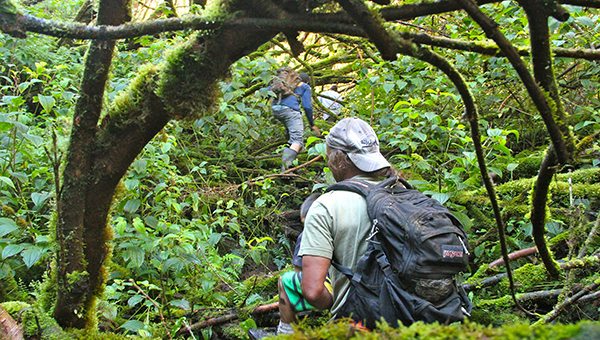 The village of Hana is on the quiet ‘windward’ side of Maui. Windward is a euphemism for rainy. Precipitation here averages 300 inches (7,600 ml) a year. No person of sound judgment would live in a place where an inch of rain in an afternoon is considered a light drizzle.
The village of Hana is on the quiet ‘windward’ side of Maui. Windward is a euphemism for rainy. Precipitation here averages 300 inches (7,600 ml) a year. No person of sound judgment would live in a place where an inch of rain in an afternoon is considered a light drizzle.
Most tourists endure the gruelling drive to Hana as a day trip, rising early to negotiate the 85-km journey with its 600-plus curves, 54 narrow bridges and frustratingly slow traffic. They choke down a fish taco and lemon bar at a roadside food stand, then snake back at a snail’s pace in darkness to the dry leeward side of the island, collapsing into bed at a fancy seaside resort in Kaanapali or Wailea, a checkmark on their Hawaiian holiday agenda firmly ticked off.
Some time ago, a clever marketer began selling T-shirts with the caption: “I survived the road to Hana!” It really is a challenging drive, so that intrepid shirt salesman is probably now a millionaire.
I’ve done enough beach holidays to fill a leaky bucket. Watching overweight tourists in undersized beach wear (throngs in thongs) has long since lost its lustre. We were looking for a change, an out-of-the-way Hawaiian adventure. There’s hardly a soul living out Hana way. So we decided to spend a week with the free spirits and Vietnam vets.
My search for accommodation in Hana was careful and meticulous. Not. I booked the first place I found on VRBO: Entabeni Cottage. But as is often the case when one ventures off the beaten track, our choice was serendipitous. We had absolute privacy, from the gorgeous ocean view to the solar-heated outdoor shower. The north wall of the cottage consists entirely of glass doors. Each morning, we awoke to a 180-degree view of the ocean and the barely discernible sound of waves crashing on the rocky shore hundreds of metres below.
“Entabeni means the place on the hill in Zulu,” explained owner Terry Kristiansen as she toured us in morning sunshine through the horticultural wonder of her amazing garden. We meandered amongst gigantic Cook pine, African tulip and mango trees. She and her husband Michael maintain a tropical nursery. I tried not to blush when she mentioned that some of the flowering plants were viviparous.
Two dogs, a cat, a goat, a multitude of chickens and a raucous gaggle of guinea fowl followed our progress. Terry’s hens lay green eggs – organically, of course. Each morning our doorstep was laden with a fresh coop-full of Entabeni’s emerald bounty.
Our Hana booking was for seven days. Perhaps a mistake? There’s purportedly nothing to do there. (A friend of mine, who is intimately familiar with Maui, asked bluntly, “You’re going to Hana? For a week?”) So, soon after arrival, we decided to scout out some adventure. We meandered into town and chatted up some locals.
“What do you do out here in Hana?” I asked Tyler, a mixed-blood Hawaiian of Portuguese pedigree.
“Not much” he replied, “sometimes we fish … when it’s not rough.” He looked ruefully out to sea as whitecaps roiled in a subtropical winter storm. A lone humpback whale breached in the distance. I concluded that there’d be no fishing on this trip.
“Sometimes we drive into town and pick up mail,” offered his cousin, who was high on friendliness but low on wisdom teeth. “And of course there’s the big meetin’ tonight at the church to vote on the offal plebiscite.”
I’m not sure what offal is but it sounds terrible.
I was about to excuse myself, vacate the cottage and head for dry, civilized parts of Maui when Tyler said:
“What we really like is hunting wild boar. We’re going out tomorrow morning. You’re welcome to come along if you don’t mind getting a little muddy.”
My expertise as a hunter is renowned. I once shot a gopher – grazing it only slightly but deeply wounding its pride. And I’ve caught two fish – three if you include the goldfish I netted in my backyard pond. Still, I figured ‘when in Rome’ and agreed to meet them in the morning at mile marker 26, near an abandoned, burned-out pickup truck.
“It’s blue,” offered my newfound toothless friend, perhaps to ensure I didn’t wait by a red, abandoned burned-out pickup truck at mile marker 26.
Terry drove me down at 7 a.m. sharp. We hadn’t waited more than a minute when up rolled a pineapple-yellow crew-cab, loaded to exploding with Hawaiians, hunting dogs and guns. The truck, high on its suspension, teetered on two wheels before finally rocking to a stop. The occupants piled out and cracked Budweisers. The humans that is. The dogs were content to slurp at the slough that had formed around the old blue pickup during the previous evening’s downpour.
Like most flora and fauna in the Hawaiian Islands, the wild pigs are alien. These invasive, destructive critters are a cross between the small Polynesian variety brought to the islands by the first human inhabitants 1,000 years ago and larger European pigs imported in the 1800s. The result is the large, black, elusive, ornery beasts that Hawaiians love to hunt.
By 7:30 a.m. we were a kilometre deep in the rainforest, up to our knees in muck. The dogs had sniffed out a promising dig. Fresh tracks confirmed that a large sow was nearby. Three hours later we were still zigzagging back and forth over, around and through jungle streams laced with invasive strangler figs and giant eucalyptus trees. The pigs were clever. On a couple of occasions, the dogs bolted excitedly into the impenetrable jungle on a promising scent, but near noon, with the tropical sun beating down and steam rising in the heated rainforest, we admitted defeat and called it a day.
“What happens if you get injured in here?” I asked Tyler as we began the slow hour-long crawl back to the pickup.
“Hurt is not a’ option,” he answered, tugging at a rubber boot sunk deep in a wallow of mud.
Back at the truck, with the last of the morning Budweiser, we conceded the feral pig’s victory over man.
“Why don’t you and your bride come down to our place tomorrow for Super Bowl,” offered Tyler. “There’ll be plenty of grind and bevvies.”
I assumed he meant food and drink.
We arrived fashionably late with a plate full of deviled (green) eggs and a cooler full of cold ones. After the game (quite exciting – not a Superbore), I asked if it would be okay were I brought out my ever-present ukulele from its coincidental resting place in the trunk of the rental car.
“That’d be great bra’,” said Tyler, using the term of endearment that forms every second word of Hawaiian pidgin vocabulary.
When I returned, a slack guitar and four ukuleles were jamming on the lanai. Uncle Bobby (whose relationship with our hosts I never did quite grasp) was pouring himself a stiff concoction, lighting a smoke and settling into an over-worn armchair for what turned out to be a long night of music and laughter.
Later in the week as we strolled Hana’s streets, locals were honking, waving “hey bra’’ and inviting us for grind. Apparently we haole (white people from another place) were a hit.
I offer seven recommendations on how to pass a week in Hana:
- walk awestruck as Terry Kristiansen guides you through the horticultural wonder that is Entabeni Cottage (whilst chickens peck at your progress);
- shower outdoors at night in the rain;
- crawl on all fours for hours through steep, muddy rainforest with a pack of men and dogs on the hunt for wild boar;
- enjoy a candle-lit repast of raw sashimi-grade ahi tuna, followed by lightly-seared opaka-paka, served with a glass of white wine by your favourite fellow hominid;
- get lit up with Hawaiian locals at a ukulele jam;
- waste a day by shooting close-up photographs of a rainbow eucalyptus tree or a densely-packed stand of bamboo;
- snorkel at a ‘clothing optional’ black sand beach, oblivious to the nudity of those around you;
- hike the seven sacred pools to Waimoku Falls or traverse the jagged lava cliffs of Waianapanapa State Park.
Did I say seven things? I guess there’s more to do in Hana than first meets the eye.
So get off the beaten track, out of the th(r)ong and seek adventure.
Troy Media travel writer Gerry Feehan, QC, lives in Red Deer, Alta. He can be reached at [email protected].
The views, opinions and positions expressed by columnists and contributors are the author’s alone. They do not inherently or expressly reflect the views, opinions and/or positions of our publication.











